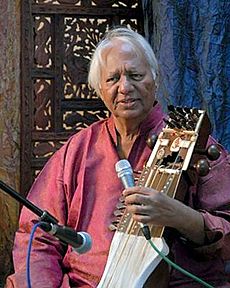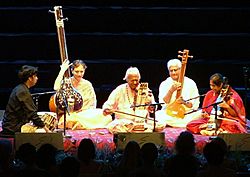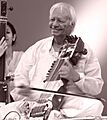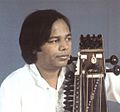Ram Narayan facts for kids
Quick facts for kids
Ram Narayan
|
|
|---|---|
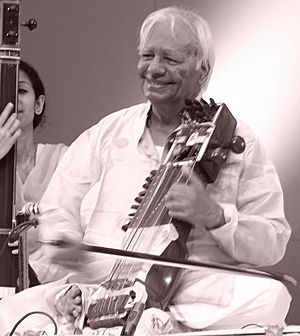
Narayan in 2010
|
|
| Background information | |
| Born | 25 December 1927 Mewar, British India |
| Died | 9 November 2024 (aged 96) |
| Genres | Hindustani classical music |
| Instruments | sarangi |
| Years active | 1944–2013 |
| Associated acts | Abdul Wahid Khan, Aruna Narayan, Brij Narayan, Chatur Lal, Suresh Talwalkar |
Ram Narayan (born 25 December 1927 – died 9 November 2024) was a famous Indian musician. He helped make the sarangi, a bowed instrument, popular as a solo instrument in Hindustani classical music. He was the first sarangi player to become famous around the world.
Narayan was born near Udaipur in India. He started learning the sarangi when he was very young. As a teenager, he worked as a music teacher and traveled to play music. In 1944, he joined All India Radio in Lahore to play music for singers.
After India was divided in 1947, Narayan moved to Delhi. He wanted to play the sarangi by himself, not just for singers. So, in 1949, he moved to Mumbai to work in Indian movies.
In 1956, Narayan started performing as a solo artist. He played at many big music festivals in India. Later, like the sitar player Ravi Shankar, Narayan also performed in Western countries. He recorded solo albums and went on his first international tour in 1964. He traveled to America and Europe with his older brother, Chatur Lal, who played the tabla drums. Narayan taught music to students from India and other countries. He kept performing, often outside India, into the 2000s. In 2005, he received the Padma Vibhushan, which is India's second highest award for civilians.
Contents
Early Life and Musical Beginnings

Ram Narayan was born on 25 December 1927, in a village called Amber, near Udaipur in northwestern India. His family had a history of music. His great-great-grandfather and great-grandfather were singers for the ruler of Udaipur. His grandfather and father were farmers and singers. His father played a bowed instrument called the dilruba.
When Ram Narayan was about six years old, he found a small sarangi. His father taught him how to play it. However, his father was worried because the sarangi was a difficult instrument and not highly respected in society. Ram Narayan's father later told him to leave school and focus only on playing the sarangi.
Around age ten, Narayan learned the basics of dhrupad, which is the oldest style of Hindustani classical music. He learned by watching and copying a sarangi player named Uday Lal. After Uday Lal passed away, Narayan met a traveling singer named Madhav Prasad. Narayan made a special promise to Prasad, becoming his student. He learned khyal, which is the most common style of Hindustani classical music today.
Narayan traveled with Prasad to different parts of India. Later, Prasad became sick and told Narayan to learn from a singer named Abdul Wahid Khan in Lahore.
A Career in Music
Narayan went to Lahore in 1943. He tried out for the local All India Radio (AIR) station as a singer. But the music producer saw marks on Narayan's fingernails. These marks are made from pressing fingernails against the sarangi strings. So, the producer hired Narayan as a sarangi player instead.
Traditionally, the sarangi plays along with a singer, copying their voice. But Narayan wanted to do more. The producer helped him meet the khyal singer Abdul Wahid Khan. Narayan learned four ragas (melodic frameworks) from Khan through singing lessons. Narayan was sometimes allowed to play solo on AIR, and he started thinking about a solo career.
After India was divided in 1947, Narayan moved to Delhi. He played at the local AIR station. He played with famous classical singers like Omkarnath Thakur and Bade Ghulam Ali Khan. Narayan's playing was so good that he often stood out, even when he was just accompanying singers. Some singers felt he was too strong in his playing, but others, like Omkarnath Thakur, admired him.
Narayan felt limited by only playing for singers. In 1949, he moved to Mumbai to work in film music. He recorded solo music, but it wasn't very popular at first. The Mumbai film industry paid well. For the next 15 years, he played and composed music for movies. Some of these films included Mughal-e-Azam and Pakeezah.
Narayan performed in Afghanistan in 1952 and in China in 1954, and people liked his music. His first solo concert in Mumbai in 1954 was cut short because the audience was waiting for more famous artists. Narayan even thought about giving up the sarangi and becoming a singer. But he later gained confidence and performed solo for smaller crowds. In 1956, he successfully played solo at a Mumbai music festival. After this, he stopped playing only as an accompanist. This was a brave choice, as solo sarangi music was not yet very popular.
After sitar player Ravi Shankar became famous in Western countries, Narayan decided to do the same. He recorded solo albums and went on his first international tour in 1964. He traveled to America and Europe with his older brother, Chatur Lal, who played tabla drums. Narayan often taught and performed concerts outside India starting in the 1960s. In the West, people were interested in the sarangi because it sounded similar to the cello and violin.
Narayan continued to perform and record music in India and abroad for many decades. His music was released by record labels in India, America, and Europe. He performed less often in the 2000s and rarely in the 2010s.
Ram Narayan's Unique Style
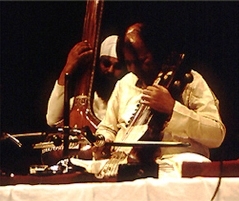
Ram Narayan's playing style is typical of Hindustani classical music. However, his choice to play the sarangi as a solo instrument was unusual. He also learned from teachers outside his own community, which was not common. He always said his goal was to make the audience happy and create a feeling of peace and harmony.
Narayan's performances usually started with a calm, slow part called alap. This was followed by a faster section with a rhythm, called gat. The gat section often included musical compositions. He would often end his performances with ragas (melodies) that allowed for extra notes, or with a dhun (a song based on folk music).
Narayan used special exercises called paltas to practice and teach. These exercises helped him play different numbers of notes with each bow stroke. He also used long musical patterns called tans for fast playing. Narayan's way of holding his left (fingering) hand and his right (bowing) hand was unique among sarangi players. He used his left hand to play many notes and a wide range of sounds. He used his right hand for rhythmic accents.
Narayan used a sarangi that was built in the 1920s or 1930s for his concerts and recordings. He even tried using foreign harp strings to make a clearer sound. He experimented with his instrument, adding a fourth string at one point, but later removed it. He also tried using steel for the first string instead of gut, but went back to all gut strings because the steel changed the sound too much. One of Narayan's sarangis is now on display in a museum in Mumbai.
Contributions and Awards
Ram Narayan greatly improved the standing of the sarangi. He made it a respected solo instrument for concerts. He was the first sarangi player to become famous internationally. His simplified fingering technique also influenced how modern sarangi players perform.
Narayan taught at music schools in Mumbai and in the United States. He also taught sarangi privately to many students, including his daughter Aruna Narayan and his grandson Harsh Narayan. He taught other musicians too, like his son Brij Narayan, who plays the sarod. By 2002, he had taught many students in India, the United States, and Europe.
Narayan believed that the sarangi only gained respect in India after Western audiences started to appreciate it. He felt that there weren't enough good sarangi teachers and that the Indian government should help save the instrument. The Pt (Pandit) Ram Narayan Foundation in Mumbai gives scholarships to students who want to learn the sarangi. Narayan always said he would keep promoting the instrument.
Narayan received many important awards from the Indian government:
- Padma Shri in 1976
- Padma Bhushan in 1991
- Padma Vibhushan in 2005 (India's second highest civilian honor)
He also received many other music awards, including the Sangeet Natak Akademi Award in 1975 and the Rajasthan Ratna in 2013. A movie about his life, called Pandit Ramnarayan – Sarangi Ke Sang, was shown at the 2007 International Film Festival of India.
Family and Personal Life
Ram Narayan had a very close relationship with his older brother, Chatur Lal. Lal learned to play the tabla drums mainly to play along with his brother's sarangi music. Lal became a famous musician and toured with other great instrumentalists like Ravi Shankar. He helped make the tabla popular in Western countries. When Lal died in 1965, Narayan found it hard to perform. Narayan helped his brother's four children after their father passed away. Chatur Lal's son, Charanjit Lal Biyavat, also plays the tabla and has toured with Narayan.
Narayan's wife, Sheela, was a homemaker. They had four children. His oldest son, Brij Narayan, born in 1952, plays the sarod. His daughter, Aruna Narayan, born in 1959, was the first woman to give a solo sarangi concert. She moved to Canada in 1984. Another son, Shiv, plays the tabla and has toured Australia with his father. Brij Narayan's son, Harsh Narayan, also plays the sarangi. This shows that music runs in their family!
In 2009, Narayan performed at BBC's The Proms in London with his daughter Aruna. In 2010, he played at the Sawai Gandharva Music Festival with his grandson Harsh.
Narayan was a Hindu and believed that "music is my religion." He said there was no better way to connect with God than through music. He lived in Mumbai. Ram Narayan passed away on 9 November 2024, at the age of 96.
Discography
Images for kids
See also
 In Spanish: Ram Narayan para niños
In Spanish: Ram Narayan para niños



